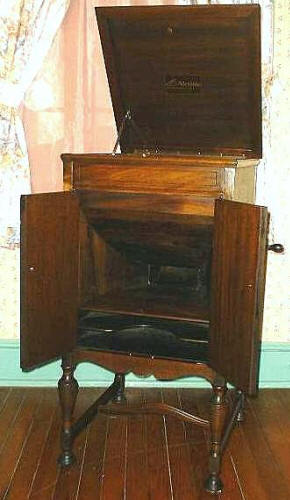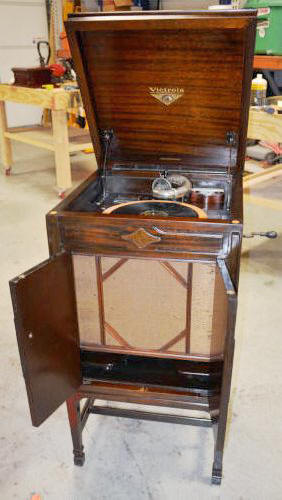
The Victor-Victrola Page
 VV
4-3 / Consolette / VE 4-3 X
VV
4-3 / Consolette / VE 4-3 X
RARITY: ¤ VALUE: ¤

 The
Consolette (later referred to as the 'VV 4-3') was one of four premiere
Orthophonic models that were introduced in the late fall of 1925. This new line
of machines
provided far better sound-quality than any of the earlier Victrola models, with
superior frequency response, higher volume, and a far less "canned" sound
quality than was experienced with the previous generation of acoustic
phonographs. For a description of the Orthophonic machine concepts, please refer
to the page: Basics of
the Acoustic Phonograph.
The
Consolette (later referred to as the 'VV 4-3') was one of four premiere
Orthophonic models that were introduced in the late fall of 1925. This new line
of machines
provided far better sound-quality than any of the earlier Victrola models, with
superior frequency response, higher volume, and a far less "canned" sound
quality than was experienced with the previous generation of acoustic
phonographs. For a description of the Orthophonic machine concepts, please refer
to the page: Basics of
the Acoustic Phonograph.
The "Consolette" model was originally designed as a conventional Victrola model in early 1925, using non-Orthophonic components. 10,000 of these machines were produced and held at the plant due to the collapse of phonograph sales during that timeframe. These pre-Orthophonic Victrolas were later sent to Latin America as 'export' models. Versions intended for Latin America will have 'slats' in the horn opening, and will use the older style Victrola No. 2 Soundbox, and were badged as "Consolette" models, with an "E" (export) letter on the suffix. See the VV 4-1 page for more information.
A 'crash program' to convert the 4-1 (already tooled-up with many completed cabinets sitting in factory stores) into an Orthophonic machine in time for the November product-line introduction was undertaken in the summer of 1925, resulting in the renaming of the machine to "Consolette" and the inclusion of the new Western Electric soundbox and tonearm. A new internal horn was re-designed as a 'force-fit' within a limited budget and restrictive 4-1 cabinet dimensions; the result (dimensionally) represents a major compromise from the desired exponential horn criteria. This resulted in only marginally improved performance from prior horns.
The Consolette was thus positioned as the lowest-priced Orthophonic model, selling for $85.00, which equates to about $1,400.00 in today's money. Early-production Consolette models (picture on left) did not even include a cover over the horn opening. Instead of the beefy 2-spring motor originally used on the "4-1", the Consolette cut-back to a basic single-spring 'pancake' motor which must be wound after each record is played. The traditional varnish finish was replaced with lower-cost lacquer. The underpowered motor, small 10" turntable, and the gaping open horn cavity that faced listeners could certainly give buyers the perception that the latest low-cost Victrolas were of substandard quality. This is especially true when the ornate cabinets and powerful motors of the previous generation of Victrolas (which in late 1925 were still available from any dealer at half-price) could be considered a better-value alternative. Regardless, given the performance improvement of the new soundbox when matched with electrical records, the little Consolette sold moderately well.
A little-known fact is that, when adapting an Orthophonic soundbox and tonearm to fit any earlier Victrola, the acoustic results are remarkably similar to that of the Consolette; this is particularly true for the larger-horn versions such as the VV-111. Of course, Victor intentionally designed the soundbox and tonearm dimensions to be slightly different for the Orthophonic machines, so as to make connections to older models more challenging. Otherwise dealers likely could have quickly sold their overstock of conventional models (selling at half-price during 1925) by demonstrating the older machines using the Orthophonic components and an electrically-recorded disc. The sound would have been virtually the same, and the cabinets were of far better manufacture. However, this idea was certainly not in Victor's best interests. When compared to the "Credenza", Victor's 'flagship' Orthophonic model, the Consolette sounded a bit anemic. Management took note, and in early 1926, the "VV 4-7" was launched, incorporating the Consolette's soundbox and tonearm, but using a far-better re-entrant horn with superior bass performance.
Listen to a direct comparison of the Credenza vs. the early Consolette. Click on the links below. Microphones were placed 6 feet in front of the horns, playing the same record and using the same soundbox in the same room. No gain or equalization adjustments have been made.
Due to a rather muted public
response at launch, a grille cloth
was soon added to cover the Consolette's horn opening, the turntable size was
increased to a full 12", and a vastly improved double-spring motor
was added to enhance its appearance and performance (these same
improvements were also made to the Colony model).
The retail price was concurrently increased by $10.00. However, for unknown reasons,
these updates were rolled-out inconsistently at the Camden plant; therefore it
is common to find Consolette models with serial numbers as high as 40000 with
only some (or none) of the aforementioned upgrades being included. It is quite
possible that the factory pulled-back those Consolette machines which were still
in inventory for a "retrofitted upgrade"; however, machines
which had already been delivered to dealers or wholesalers would have retained the earlier
(non-upgraded) design features. Based on information from surviving examples,
this appears to be the most likely scenario.
concurrently increased by $10.00. However, for unknown reasons,
these updates were rolled-out inconsistently at the Camden plant; therefore it
is common to find Consolette models with serial numbers as high as 40000 with
only some (or none) of the aforementioned upgrades being included. It is quite
possible that the factory pulled-back those Consolette machines which were still
in inventory for a "retrofitted upgrade"; however, machines
which had already been delivered to dealers or wholesalers would have retained the earlier
(non-upgraded) design features. Based on information from surviving examples,
this appears to be the most likely scenario.
By the spring of 1926, the Consolette name was changed to the VV 4-3,
and factory production output became consistent; with its powerful and quiet
2-spring motor and an improved overall appearance, sales of the 4-3 began to
markedly improve.
In the summer of 1927, the 4-3 underwent a total design change to feature a
larger cabinet with a modern, high-quality appearance (picture on right). Sales
skyrocketed in 1927 and 1928, making the 4-3 one of Victor's most popular models
ever produced. The 4-3 was gradually discontinued from production in early 1929
when low-cost electronically-amplified phonographs became commonly available.
The 4-3 was also available with an electric motor option (VE 4-3) for
$35.00 extra, bringing the total cost to $135.00. Production for these
electrically-powered models began on a low-volume basis in the spring of 1926,
but it was never a big seller. Production logs show that approximately 7,500 of
these machines were produced, however the serial numbers of surviving examples
indicate that at least 8,000 were made.
The Consolette / VV 4-3 was available only in a blended-stain mahogany finish
and bright nickel-plated hardware was provided. A
total of 242,000 Victrola 4-3 (spring and electric) machines were produced.
The current survival database shows the earliest existent Consolette (4-3) to be S/N 932 and the latest to be S/N 238070
The earliest existent electric (VE) 4-3 is S/N 740 and the latest is S/N 8896
| Manufacture Date | Serial Number Range | Feature Notes |
| 1925 | 501-30000 | No grille cloth over horn. 10" turntable, single-spring motor. See note above regarding inconsistent production builds during late 1925 and early 1926. |
| 1926 | 30000-65500 | Name changed to "4-3" and turntable enlarged to 12" in the Spring of 1926. Auto brake added at s/n 39501. |
| 1927 | 65500-156500 | Cabinet design modernized at s/n 91000 |
| 1928 | 156500-223000 | |
| 1929 | 223000-234824 | Higher serial numbers have been reported |
| VE 4-3 Electric: | ||
| 1925 | None | |
| 1926 | 501-4300 | All VE 4-3's have a horn cover cloth |
| 1927 | 4300-6600 | Cabinet design modernized at s/n 6401 |
| 1928 | 6600-7750 | |
| 1929 | 7750-7929 | Higher serial numbers have been reported |
Do you own a Victor Consolette / 4-3? Please take a moment and enter some basic information about your machine into the collector's database by clicking here. No personal information is required.